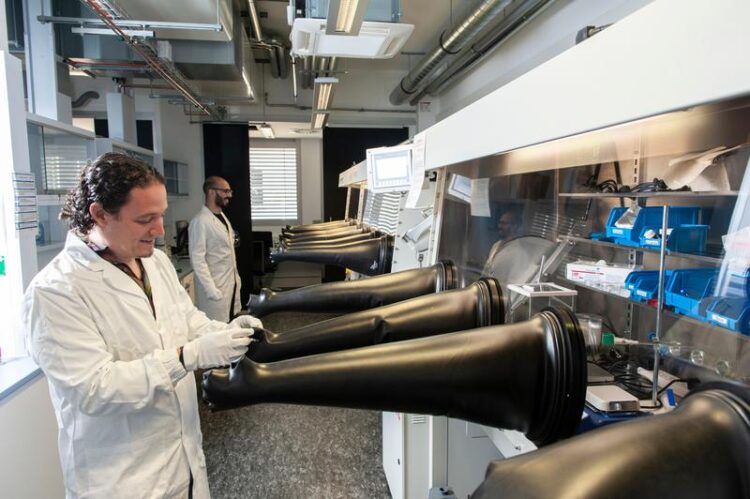Bright, stable, and easy to recycle lighting

Prof. Dr. Rubén D. Costa (l.), Professor of Biogenic Functional Materials at the TUM Straubing Campus for Biotechnology and Sustainability at the Technical University of Munich (TUM), and PhD student Luca Cavinato in the lab working on a glove system.
Jan Winter / TUM
A low-cost and easy-to-manufacture lighting technology can be made with light-emitting electrochemical cells. Such cells are thin-film electronic and ionic devices that generate light after a low voltage is applied. Researchers at the Technical University of Munich (TUM) and the University of Turin have now used extensive data analysis to create first-class electrochemical cells from copper complexes that emit blue and white light.
Light-emitting electrochemical cells (LECs) are the simplest and least expensive thin-film lighting devices available to date. They consist of a single active layer. They are used, for example, as electroluminescent inks and stickers.
The effect of electroluminescence was first demonstrated in 1905. At that time, two scientists detected the presence of light under applied voltage in various minerals and metals and were able to correlate the intensity to voltage and heat generation. Their prototypes are considered to be the first LEDs. “However, technical use of the effect became possible only later and whereas the well-known light-emitting diodes or LEDs are semiconductor devices that emit light when an electrical voltage is applied, the light-emitting electrochemical cells or LECs that we are looking at follow a different principle,” explains Rubén D. Costa, Professor of Biogenic Functional Materials at TUM.
Transition from laboratory to real market difficult so far
The research groups of Professor Ruben D. Costa at the TUM Campus Straubing for Biotechnology and Sustainability and Professor Claudia Barolo at the University of Turin have now developed the first approach to developing LEC emitters in so-called active layers. Based on copper(l) complexes, these LECs create excellent blue and white light.
“The development of inexpensive devices that emit white and blue light is highly desired and holds many benefits. However, the previous lack of blue emitters has hindered the transition from the laboratory to the real market. Accordingly, the creation of blue emitters is a general milestone in thin-film lighting. Once blue devices are here, we will be able to make white light devices relatively easily,” says Professor Costa. It is precisely blue emitters that the research groups have now succeeded in creating.
Data science as a new approach
The research groups from Straubing and Turin have successfully used data science tools to establish a statistical relationship between the x-ray structure and the electronic features of the copper(l) complexes dimine and diphosphine ligands. At the same time, they have studied the structural and electronic parameters and their interrelationships to determine the emission color, efficiency, and luminescence of the devices.
After extensive data evaluation of various known approaches, a new design has emerged for blue LECs which provide excellent performance as compared to devices with conventional emitters.
High-performance white LECs with copper(l) complexes
“With the new high-performance blue LECs, copper(l) based single-layer white LECs with high quality white light and a color rendering index of 90 can be realized,” says Professor Claudia Barolo of the University of Turin. The color rendering index indicates how natural colors of illuminated objects appear under a given light source and has a maximum value of 100, so a value of 90 is already very good.
This work points to a new way to streamline the design of emitters and active layers in thin-film lighting. “We are convinced that our analytical model is a first step towards advanced machine learning methods for the fine design of other active compounds as well,” states professor Costa.
Wissenschaftliche Ansprechpartner:
Prof. Rubén D. Costa
Chair of Biogenic Functional Materials
Technical University of Munich
Schulgasse 22
D-94315 Straubing, Germany
Phone: +49 9421 187470
ruben.costa@tum.de
Originalpublikation:
Cavinato, L. M., Wölfl, S., Pöthig, A., Fresta, E., Garino, C., Fernandez-Cestau, J., Barolo, C., Costa, R. D., Multivariate Analysis Identifying [Cu(N^N)(P^P)]+ Design and Device Architecture Enables First-Class Blue and White Light-Emitting Electrochemical Cells. Adv. Mater. 2022, 2109228. URL: https://onlinelibrary.wiley.com/doi/10.1002/adma.202109228
Weitere Informationen:
https://www.tum.de/en/about-tum/news/press-releases/details/37363 (press release)
https://mediatum.ub.tum.de/1657558 (images)
https://bfm.cs.tum.de/?lang=en (Chair of Biogenic Functional Materials)
Media Contact
All latest news from the category: Power and Electrical Engineering
This topic covers issues related to energy generation, conversion, transportation and consumption and how the industry is addressing the challenge of energy efficiency in general.
innovations-report provides in-depth and informative reports and articles on subjects ranging from wind energy, fuel cell technology, solar energy, geothermal energy, petroleum, gas, nuclear engineering, alternative energy and energy efficiency to fusion, hydrogen and superconductor technologies.
Newest articles

Innovative 3D printed scaffolds offer new hope for bone healing
Researchers at the Institute for Bioengineering of Catalonia have developed novel 3D printed PLA-CaP scaffolds that promote blood vessel formation, ensuring better healing and regeneration of bone tissue. Bone is…

The surprising role of gut infection in Alzheimer’s disease
ASU- and Banner Alzheimer’s Institute-led study implicates link between a common virus and the disease, which travels from the gut to the brain and may be a target for antiviral…

Molecular gardening: New enzymes discovered for protein modification pruning
How deubiquitinases USP53 and USP54 cleave long polyubiquitin chains and how the former is linked to liver disease in children. Deubiquitinases (DUBs) are enzymes used by cells to trim protein…



